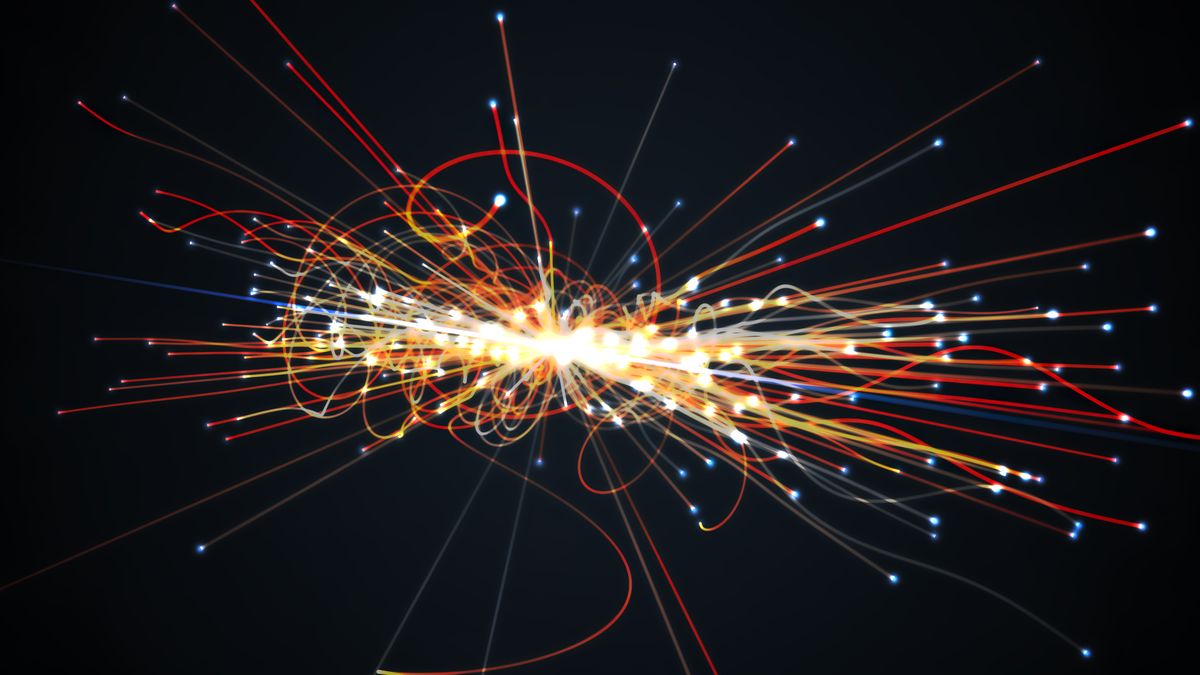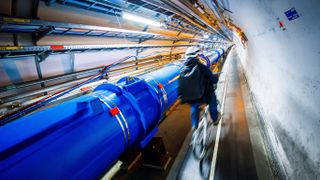Strange pattern found inside world’s largest atom smasher has physicists excited
Physicists could be on the verge of a major breakthrough as new results hint at a challenge to the standard model of particle physics.

Scientists working at the world's largest atom smasher have spotted a strange pattern in their data that cannot be explained by the current laws of nature.
One of the four enormous collider experiments being run at the Large Hadron Collider (LHC) in Geneva, has found that so-called beauty quarks (or bottom quarks) are not behaving the way that they should according to our best theory for how the basic building blocks of matter interact: the Standard Model.
If the wacky particle behavior is real and not just some random occurrence, it has massive implications for physicists' understanding of matter and the basic rules that govern the universe. It could lead to the discovery of a new fundamental force of nature, or the replacement of the Standard Model with an even deeper theory.
"We were actually shaking when we first looked at the results, we were that excited. Our hearts did beat a bit faster." Mitesh Patel of Imperial College London, one of the leading physicists working on the experiment, said in a statement. "It's too early to say if this genuinely is a deviation from the Standard Model, but the potential implications are such that these results are the most exciting thing I've done in 20 years in the field. It has been a long journey to get here."
Related: Beyond Higgs: 5 Elusive Particles That May Lurk in the Universe
Inside the LHC — a 17-mile-long (27 kilometers) underground ring — protons zip around at near light-speed and then slam into each other. The result? New and sometimes exotic particles form from those collisions. The faster those protons go, the more energy they have. And the more energy they have, the more massive the resulting particles can be. Atom smashers like the LHC detect possible new particles by looking for telltale decay products, as the heavier particles are generally short-lived and immediately break down into lighter particles.
One of the LHC's goals is to test the Standard Model, the mathematical framework physicists use to describe all of the known fundamental particles in the universe and the forces through which they interact. Though the model has been around in its final form since the mid-1970s, physicists are far from satisfied with it and are constantly looking for new ways to test it and, if they're lucky, make it fail.
Sign up for the Live Science daily newsletter now
Get the world’s most fascinating discoveries delivered straight to your inbox.
This is because the model, despite being our most comprehensive and accurate for particle physics, includes enormous gaps, making it totally incapable of explaining where the force of gravity comes from, what dark matter is made up of, and why there is so much more matter than antimatter in the universe.
The model also predicts that when heavier particles break down, they should break down into electrons just as often as they do into their heavier cousin, the muon. That's because the Standard Model views the muon as being perfectly identical to the electron, except for the fact that the muon is roughly 200 times heavier. The two of them, along with the tau particle, make up a family of very close relatives in the particle zoo called leptons.

But since 2014, physicists observing particle decays at the LHCb say they have been building up quite a different picture that involves one of the six flavors of quarks (those itty bitty particles that make up protons and neutrons scrunched inside atomic nuclei): When a type of particle called the beauty quark decays, it seems to produce electrons far more often than it does muons. This is a major contradiction of the Standard Model. But first the physicists will need to prove beyond doubt that the finding is a real one.
"It's a really intriguing result, but we need to prove it's statistically significant first," Chris Parkes, an experimental particle physicist at the University of Manchester and spokesperson for the LHC beauty (LHCb) collaboration, which ran the experiment, told Live Science. "If you flip a coin five times in a row and it lands tails every time, then that's just a bit strange. If you then flip it 100 times more and it's still only landing tails, then there's something weird about that coin."
Parkes believes that the likelihood that the result is just a fluke is 1 in 1,000. In order for the collaboration to declare a new discovery, these odds have to be narrowed to about 1 in 1,000,000. But the researchers say they will be able to do that very soon.
"Normally, when you spot a result like this you're thinking: 'Gee we've got to build a new collider,'" Parkes said, referring to the fact that to continue finding new particles, colliders must be capable of accelerating particles to even higher energies. "The really exciting thing is, now that we've got this intriguing hint, we already have lots of data that we're analyzing to find more signs."
The LHCb is also currently installing the next-generation version of its detector. When this detector comes online next year, Parkes expects it will be even more sensitive to picking up the radiation emitted by the particles formed during high-energy collisions.
In spite of the uncertainty surrounding this one result, Parkes said that when it is combined with other promising results on beauty quark decays, it has led to an atmosphere of cautious excitement at CERN, the research organization that runs the LHC.
This is because if the result is true, it could be explained by the existence of particles or forces previously unknown to physics. One example could be the leptoquark, he said, which is a particle capable of interacting with both leptons and quarks. Another possibility is that there could be a completely new fundamental force altogether.
"The great thing is that a lot of this analysis is already underway," Parkes said. "We're not talking about having answers in the next few weeks, but neither are we talking about waiting around for years, either."
Originally published on Live Science.

Ben Turner is a U.K. based staff writer at Live Science. He covers physics and astronomy, among other topics like tech and climate change. He graduated from University College London with a degree in particle physics before training as a journalist. When he's not writing, Ben enjoys reading literature, playing the guitar and embarrassing himself with chess.